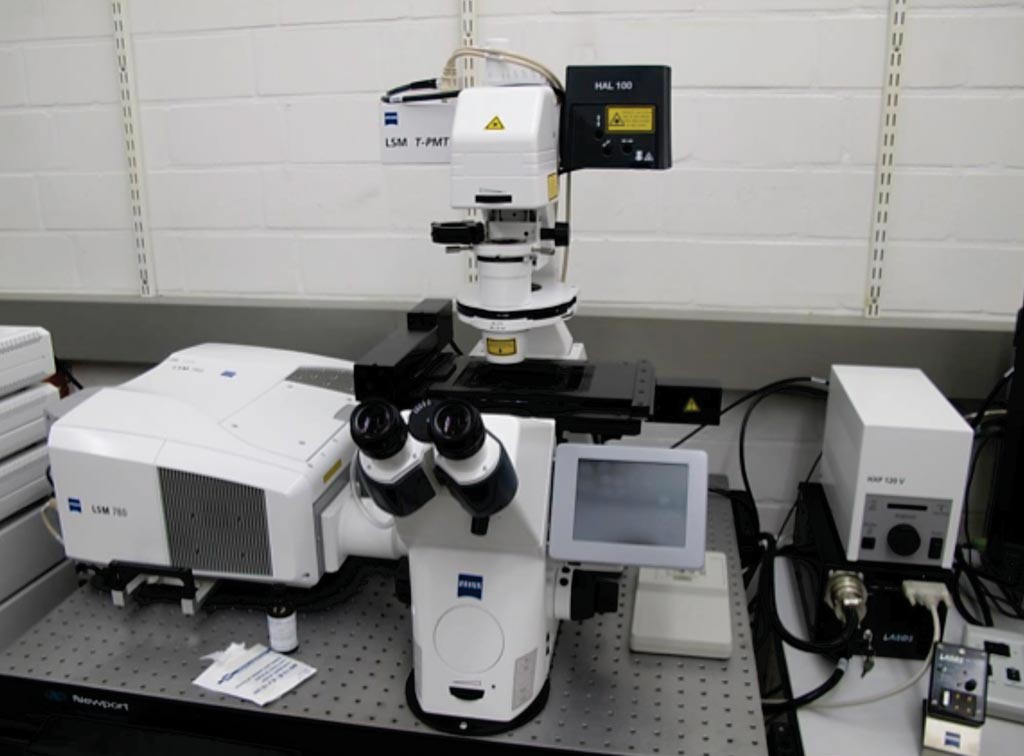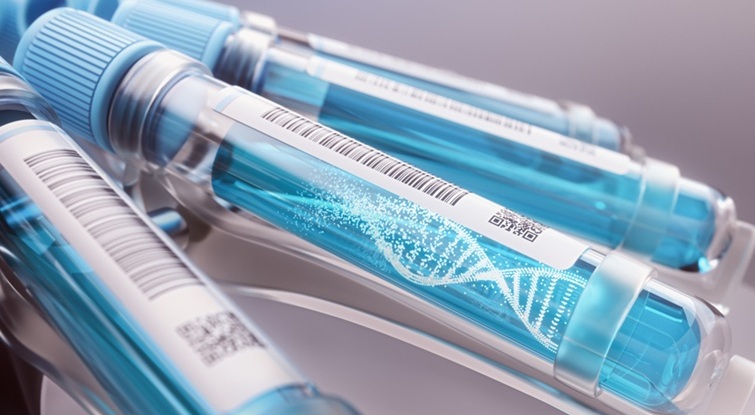Biomarker Identified for Novel Asthma Treatment
|
By LabMedica International staff writers Posted on 17 Sep 2018 |

Image: The LSM 780 inverted laser scanning confocal microscope (Photo courtesy of Zeiss).
Asthma is a widespread chronic airway disease characterized by airway obstruction, inflammation, and hyperresponsiveness. Symptoms such as bronchoconstriction and cough range from mild intermittent to severe persistent.
In eosinophilic asthma, the most common form of asthma, eosinophils in the airway alter nerve function and exacerbate the disease. However, whether eosinophils also affect airway nerve structure is unclear. In type 2-high asthma, interleukin-5 (IL-5) promotes eosinophil maturation, recruitment, and survival.
An international team of scientists working with the Oregon Health and Science University (Portland, OR, USA) evaluated airway sensory innervation and eosinophilia in humans with and without asthma and to characterize the physiologic consequences of eosinophil and airway nerve interactions using transgenic mice. Patients over the age of 17 were recruited and medication use, pulmonary function testing, blood eosinophil counts, serum immunoglobulin E (IgE) levels, and smoking history were obtained.
Human bronchial biopsies (three to five per subject) were taken from the bifurcation of the right middle lobe and immediately fixed in formalin overnight. Tissues were immunostained at 4 °C on a shaker. Airway nerves were labeled with rabbit polyclonal antibody against pan-neuronal marker PGP9.5 (protein gene product 9.5), and other immunostaining was performed and images were acquired using a Zeiss LSM 780 confocal microscope.
The scientists reported that subjects with a type 2-high asthma phenotype, defined as blood eosinophils greater than 300 cells/μL, had longer airway nerves and increased nerve branch points compared to control airways. In contrast, nerves in type 2-low asthmatics with blood eosinophils less than 300 cells/μL were not significantly different from healthy subjects. The mean blood eosinophils counts were 182 ± 93 μL in the 19 controls; 277 ± 289/μL in the 13 intermittent asthma patients; and 301 ± 225/μL in the persistent asthma sufferers. Moderate persistent asthmatics had increased eosinophil peroxidase both above and below the epithelial basement membrane compared to mild intermittent asthmatics and control subjects.
The authors concluded that their data indicated that airway nerves contribute to asthma pathology. They have shown that moderate persistent asthmatics have increased airway sensory innervation that is especially marked in asthmatics with accompanying eosinophilia. Richard W. Costello, MB, MD, FRCPI, a professor and a senior author of the study, said, “We identified that inflammatory cells, in particular, eosinophils, promote airway nerve growth in patients with asthma. These observations provide a unique insight into a fundamental mechanism of how the inflammation caused by asthma causes people to experience the symptoms of asthma such as coughing and breathlessness. This means that we now know which markers to look for in a patient with severe asthma. A patient with markers which show they have this particular form of asthma is likely to respond well to these new treatments.” The study was published on September 5, 2018, in the journal Science Translational Medicine.
Related Links:
Oregon Health and Science University
In eosinophilic asthma, the most common form of asthma, eosinophils in the airway alter nerve function and exacerbate the disease. However, whether eosinophils also affect airway nerve structure is unclear. In type 2-high asthma, interleukin-5 (IL-5) promotes eosinophil maturation, recruitment, and survival.
An international team of scientists working with the Oregon Health and Science University (Portland, OR, USA) evaluated airway sensory innervation and eosinophilia in humans with and without asthma and to characterize the physiologic consequences of eosinophil and airway nerve interactions using transgenic mice. Patients over the age of 17 were recruited and medication use, pulmonary function testing, blood eosinophil counts, serum immunoglobulin E (IgE) levels, and smoking history were obtained.
Human bronchial biopsies (three to five per subject) were taken from the bifurcation of the right middle lobe and immediately fixed in formalin overnight. Tissues were immunostained at 4 °C on a shaker. Airway nerves were labeled with rabbit polyclonal antibody against pan-neuronal marker PGP9.5 (protein gene product 9.5), and other immunostaining was performed and images were acquired using a Zeiss LSM 780 confocal microscope.
The scientists reported that subjects with a type 2-high asthma phenotype, defined as blood eosinophils greater than 300 cells/μL, had longer airway nerves and increased nerve branch points compared to control airways. In contrast, nerves in type 2-low asthmatics with blood eosinophils less than 300 cells/μL were not significantly different from healthy subjects. The mean blood eosinophils counts were 182 ± 93 μL in the 19 controls; 277 ± 289/μL in the 13 intermittent asthma patients; and 301 ± 225/μL in the persistent asthma sufferers. Moderate persistent asthmatics had increased eosinophil peroxidase both above and below the epithelial basement membrane compared to mild intermittent asthmatics and control subjects.
The authors concluded that their data indicated that airway nerves contribute to asthma pathology. They have shown that moderate persistent asthmatics have increased airway sensory innervation that is especially marked in asthmatics with accompanying eosinophilia. Richard W. Costello, MB, MD, FRCPI, a professor and a senior author of the study, said, “We identified that inflammatory cells, in particular, eosinophils, promote airway nerve growth in patients with asthma. These observations provide a unique insight into a fundamental mechanism of how the inflammation caused by asthma causes people to experience the symptoms of asthma such as coughing and breathlessness. This means that we now know which markers to look for in a patient with severe asthma. A patient with markers which show they have this particular form of asthma is likely to respond well to these new treatments.” The study was published on September 5, 2018, in the journal Science Translational Medicine.
Related Links:
Oregon Health and Science University
Latest Immunology News
- Ultrasensitive Liquid Biopsy Demonstrates Efficacy in Predicting Immunotherapy Response
- Blood Test Could Identify Colon Cancer Patients to Benefit from NSAIDs
- Blood Test Could Detect Adverse Immunotherapy Effects
- Routine Blood Test Can Predict Who Benefits Most from CAR T-Cell Therapy
- New Test Distinguishes Vaccine-Induced False Positives from Active HIV Infection
- Gene Signature Test Predicts Response to Key Breast Cancer Treatment
- Chip Captures Cancer Cells from Blood to Help Select Right Breast Cancer Treatment
- Blood-Based Liquid Biopsy Model Analyzes Immunotherapy Effectiveness
- Signature Genes Predict T-Cell Expansion in Cancer Immunotherapy
- Molecular Microscope Diagnostic System Assesses Lung Transplant Rejection
- Blood Test Tracks Treatment Resistance in High-Grade Serous Ovarian Cancer
- Luminescent Probe Measures Immune Cell Activity in Real Time
- Blood-Based Immune Cell Signatures Could Guide Treatment Decisions for Critically Ill Patients
- Novel Tool Predicts Most Effective Multiple Sclerosis Medication for Patients
- Companion Diagnostic Test for CRC Patients Identifies Eligible Treatment Population
- Novel Tool Uses Deep Learning for Precision Cancer Therapy
Channels
Clinical Chemistry
view channel
Compact Raman Imaging System Detects Subtle Tumor Signals
Accurate cancer diagnosis often depends on labor-intensive tissue staining and expert pathological review, which can delay results and limit access to rapid screening. These conventional methods also make... Read more
Noninvasive Blood-Glucose Monitoring to Replace Finger Pricks for Diabetics
People with diabetes often need to measure their blood glucose multiple times a day, most commonly through finger-prick blood tests or implanted sensors. These methods can be painful, inconvenient, and... Read moreMolecular Diagnostics
view channel
Urine Test Could Reveal Real Age and Life Span
Chronological age does not always reflect how quickly the body is aging, as biological age is shaped by genetics, stress, sleep, nutrition, and lifestyle factors such as smoking. A higher biological age... Read more
Genomic Test Identifies African Americans at Risk for Early Prostate Cancer Recurrence
Prostate cancer is one of the most commonly diagnosed cancers in men and a leading cause of cancer-related death, particularly in the United States. African American men face a disproportionately higher... Read moreImmunology
view channel
Ultrasensitive Liquid Biopsy Demonstrates Efficacy in Predicting Immunotherapy Response
Immunotherapy has transformed cancer treatment, but only a small proportion of patients experience lasting benefit, with response rates often remaining between 10% and 20%. Clinicians currently lack reliable... Read more
Blood Test Could Identify Colon Cancer Patients to Benefit from NSAIDs
Colon cancer remains a major cause of cancer-related illness, with many patients facing relapse even after surgery and chemotherapy. Up to 40% of people with stage III disease experience recurrence, highlighting... Read moreMicrobiology
view channel
New UTI Diagnosis Method Delivers Antibiotic Resistance Results 24 Hours Earlier
Urinary tract infections affect around 152 million people every year, making them one of the most common bacterial infections worldwide. In routine medical practice, diagnosis often relies on rapid urine... Read more
Breakthroughs in Microbial Analysis to Enhance Disease Prediction
Microorganisms shape human health, ecosystems, and the planet’s climate, yet identifying them and understanding how they are related remains a major scientific challenge. Even with modern DNA sequencing,... Read morePathology
view channel
Genetics and AI Improve Diagnosis of Aortic Stenosis
Aortic stenosis is a progressive narrowing of the aortic valve that restricts blood flow from the heart and can be fatal if left untreated. There are currently no medical therapies that can prevent or... Read more
AI Tool Simultaneously Identifies Genetic Mutations and Disease Type
Interpreting genetic test results remains a major challenge in modern medicine, particularly for rare and complex diseases. While existing tools can indicate whether a genetic mutation is harmful, they... Read more
Rapid Low-Cost Tests Can Prevent Child Deaths from Contaminated Medicinal Syrups
Medicinal syrups contaminated with toxic chemicals have caused the deaths of hundreds of children worldwide, exposing a critical gap in how these products are tested before reaching patients.... Read more
Tumor Signals in Saliva and Blood Enable Non-Invasive Monitoring of Head and Neck Cancer
Head and neck cancers are among the most aggressive malignancies worldwide, with nearly 900,000 new cases diagnosed each year. Monitoring these cancers for recurrence or relapse typically relies on tissue... Read moreTechnology
view channel
Pioneering Blood Test Detects Lung Cancer Using Infrared Imaging
Detecting cancer early and tracking how it responds to treatment remains a major challenge, particularly when cancer cells are present in extremely low numbers in the bloodstream. Circulating tumor cells... Read more
AI Predicts Colorectal Cancer Survival Using Clinical and Molecular Features
Colorectal cancer is one of the most common and deadly cancers worldwide, and accurately predicting patient survival remains a major clinical challenge. Traditional prognostic tools often rely on either... Read moreIndustry
view channel
BD and Penn Institute Collaborate to Advance Immunotherapy through Flow Cytometry
BD (Becton, Dickinson and Company, Franklin Lakes, NJ, USA) has entered into a strategic collaboration with the Institute for Immunology and Immune Health (I3H, Philadelphia, PA, USA) at the University... Read more





















